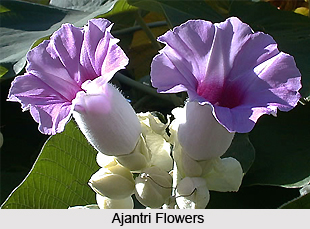 Ajantri owns the botanical name Argyreia nervosa (Burm. f.) Bojer. The same plant is recognised as `Bichtarak` in Bengali, `Woolly morning glory` in English, `Chandrapada` in Telugu, `Samandarkaphal` in Hindi, `Chandrapada` in Kannada, `Samudrapala` in Malayalam and `Samandarsotha` in Urdu. According to demand this plant is recognised by people of distinct states. This plant is recognised by the name of `Samudrasoka` in Maharashtra, `Bryddhotareko` by the people of Orissa, `Kadal pala` by the people of Tamil Nadu, `Samudrashok` by the inhabitants of Gujarat.
Ajantri owns the botanical name Argyreia nervosa (Burm. f.) Bojer. The same plant is recognised as `Bichtarak` in Bengali, `Woolly morning glory` in English, `Chandrapada` in Telugu, `Samandarkaphal` in Hindi, `Chandrapada` in Kannada, `Samudrapala` in Malayalam and `Samandarsotha` in Urdu. According to demand this plant is recognised by people of distinct states. This plant is recognised by the name of `Samudrasoka` in Maharashtra, `Bryddhotareko` by the people of Orissa, `Kadal pala` by the people of Tamil Nadu, `Samudrashok` by the inhabitants of Gujarat.
Ajantri plant is found in India from Assam and Bengal southwards to Karnataka and Tamilnadu to an elevation of 900 metre on the eastern slopes of the Western Ghats. This plant is sometimes cultivated in India and other tropical countries. It is typically found on riverbanks and at edges of lakes, and in the understorey of forests over bushes. This medicinal plant is uncommon in dry western regions.
Ajantri is an extensive woody climber with a stout stem. The young shoots and branches of this plant are covered by a silky white pubescence. Leaves are ovate cordate, apiculate at tip, 7.5cm to 30cm in diameter, glabrous above and beneath is covered with velvety white tomentose. Flowers are rose purple in colour with 7.5cm to 30cm long white tomentose peduncles and are borne in axillary many flowered cymes. The bracts are ovate lanceolate, acuminate and are 3cm to 4cm long. Fruits are globose, 2 cm in diameter, apiculate and indehiscent. Flowers generally blossom from August to September and fruits come out from October to December in central India.
In traditional Indian medicine the whole plant is prescribed for treating gleet, gonorrhoea, strangury and chronic ulcers. The leaves are emollient (upper surface) and vesicant (lower surface), and are used externally to treat itching, boils, wounds, ringworm, eczema and other skin diseases, and internally to cure boils and swellings. The leaves are also used as a local stimulant and rubifacient. The seeds of Ajantri are mixed with those of Hygrophila auriculata and H. spinosa [Acanthaceae], are used as a tonic. The seeds also have a marked hypotensive and spasmolytic effect. The root is considered bitter, aphrodisiac and diuretic. The root of the plant is used as a tonic and is used to treat gonorrhoea, rheumatism and diseases of the nervous system. In Kerala the root of Ajantri is used by some Ayurvedic physicians as the source of Murva, used to treat urinary, heart and skin diseases and intermittent fevers. It is an ingredient of a compound drug known as Ajmadadi churna, used for treating hemi plegia and rheumatism. A paste of the roots, mixed with those of Asparagus racemosus [Asparagaceae], Grewia hirsuta (Tiliaceae) and Hemidesmus indicus (Asclepiadaceae),are used to treat chronic cough and cold and related fever. The root is often ground in rice water and the entire mixture is used as an external application to the head to treat migraine among the Rabari in the Barda Hills of Gujarat. A preparation known as Fortege, prepared from this plant and several other ingredients, is used for treating common male sexual disorders.



















